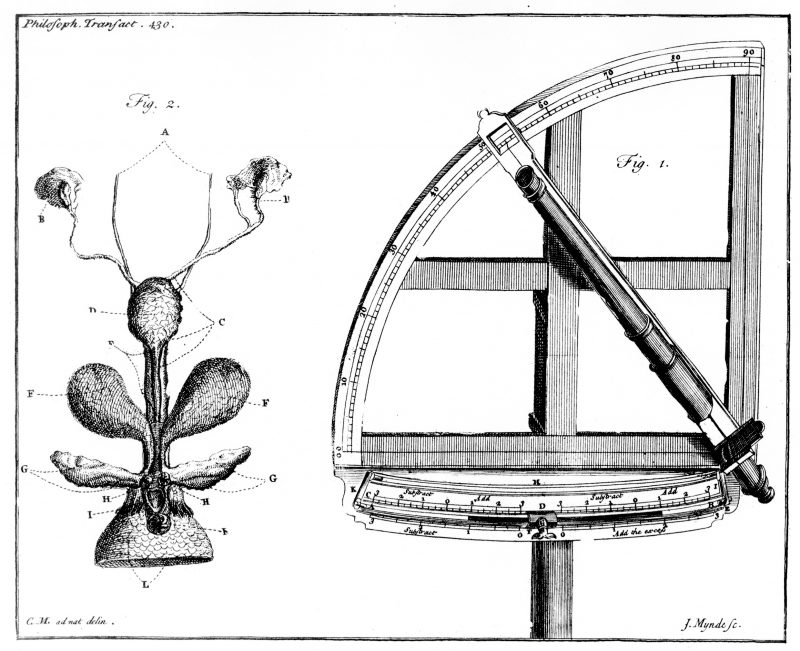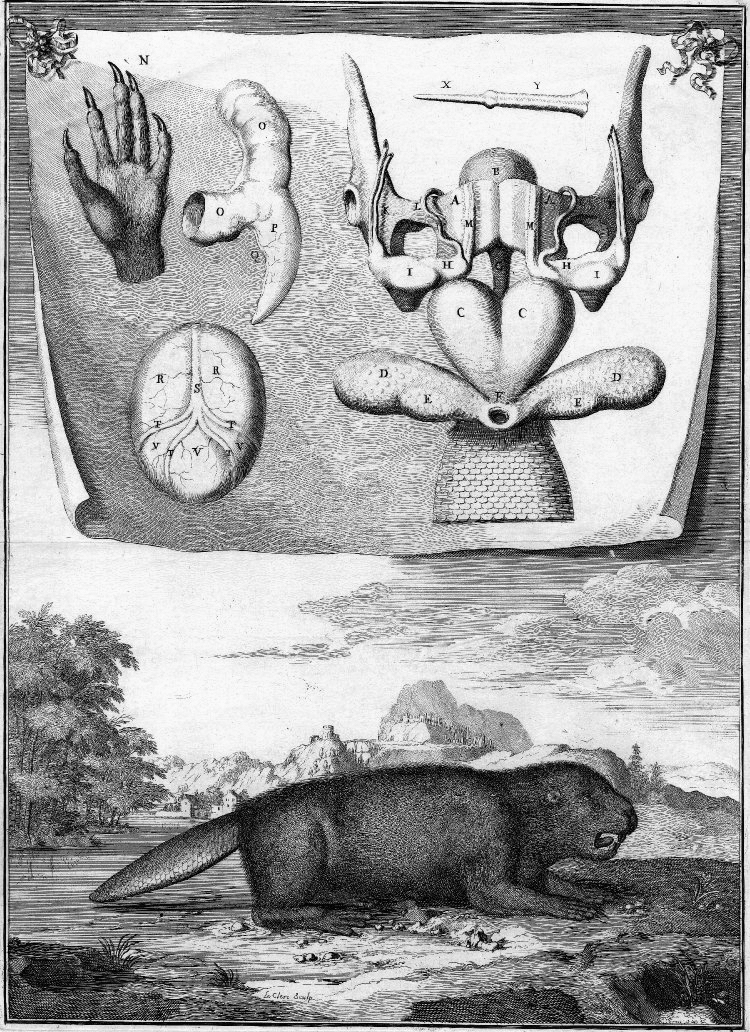I. THE SUM TOTAL OF THE BEAVER
The great British collector, naturalist, and physician Sir Hans Sloane kept a young female beaver in his garden in the fashionable Bloomsbury District at the center of London. She was a paunch-bellied beast and only half grown, measuring thirty inches from the tip of her nose to the end of her tail. She lived mainly on bread, which she held with both paws, sitting on her haunches like a squirrel. Occasionally she nibbled the willow boughs that were brought for her, but she preferred the vines growing in Sloane’s garden and gnawed several of them down to the roots. She was never heard to make any noise, except a few short grunts when chased or angered. Most of all she loved to swim in a fountain filled with live flounder, which she ignored. Her excrement was jet black and extraordinarily fetid. Her urine was turbid, white, and pungent. Where the beaver hailed from, who sent her to Sloane, and when she came to the garden are lost to time, but she was decidedly dead three months after her arrival, when Cromwell Mortimer, Sloane’s neighbor and good friend, dissected her remains, in 1733. The beaver had suffered a bout of convulsive fits. She recovered and was well enough until the day she was torn apart by a dog.
This much we know from a paper Mortimer published in Philosophical Transactions. At the time of the beaver’s death, Mortimer and Sloane were at the heart of London’s scientific community. Sloane was president of the Royal Society of London for Improving Natural Knowledge, succeeding Isaac Newton in the position. Mortimer was the society’s secretary, and, as secretary, he was responsible for circulating any and all noteworthy observations, experimentations, and innovations in the society’s journal, none other than Philosophical Transactions.

Taken on its own, Mortimer’s sketch of a beaver ambling about an English garden hardly constituted useful knowledge for his enlightened readers. After all, this was the eighteenth century. Daniel Gabriel Fahrenheit invented the mercury thermometer in 1714. Edmond Halley had discovered the proper motion of the stars in 1718. And Carl Linnaeus would publish the first edition of his revolutionary ordering system, Systema Naturae, in 1735. The new natural philosopher discovered the world and its laws by investigation and experiment, accumulating natural facts by slow and precise observation. Which is to say, properly scrutinizing a beaver, by eighteenth-century standards, required an exhaustive description of the sum total of the beaver, or, as Mortimer entitled his paper, “The Anatomy of a Female Beaver, and an Account of Castor Found in Her.”
II. False Testicle Tales
Castor, more commonly known as castoreum, is the potent-smelling, yellowish, sticky secretion from a beaver’s anal scent glands, mashed together with the dried and macerated gland itself. It has been used extensively in perfumery and as a fixative in soaps and lotions. It is also used as a vanilla flavoring in baked goods, frozen dairy products, candy, puddings, nonalcoholic beverages, and chewing gum. (The United States Food and Drug Administration estimates the daily intake per capita of castoreum is around 0.01261 milligrams.) However, for most of human history, castoreum has been highly prized for its fabled medicinal properties.
The ancient Roman Pliny the Elder claimed that castoreum induced miscarriage—if a pregnant woman stepped over a jar of it, or over a beaver itself, abortion would be the sure result. Castoreum was an excitant for patients suffering from lethargy, an antispasmodic, and—if used as a suppository—it dispelled hysterical suffocations. (A footnote from my 1857 translation of Pliny’s text observes that “castor is still given to females to inhale, when suffering from hysteria.”) Pliny claimed castoreum helped with vertigo, fits of trembling, affections of the sinews, sciatica, stomachic complaints, and epilepsy. Taken with vinegar, it cured hiccups. When beaten with oil and injected into the ear, it cured a toothache on the same side.
Pliny also narrates the dark little tale of self-castrating beavers. Confusing a beaver’s scent glands for testicles, a myth spread that a cornered beaver would bite off his own testes, rolling them toward the hunter in the hope of escaping with his life.
Pliny was aware that physician-philosopher Quintus Sextius had discredited the myth. However, the story had been around too long and was too deliciously perverse to expire just from the words of one careful observer. Among the earliest versions of the tale is “The Beaver and His Testicles,” included in Aesop’s fables, which concludes with this pithy moral: “If only people would take the same approach and agree to be deprived of their possessions in order to live lives free from danger; no one, after all, would set a trap for someone already stripped to the skin.” The seventh-century scholar Isidore of Seville added an etymological elegancy to the tale by erroneously claiming that the word castor was derived from the Latin verb castrare, “to castrate.” (In fact, the Greek word for “beaver,” castor, is derived from the ancient Sanskrit word for “musk,” kasturi. The original Latin word for “beaver” is fiber. For better or worse, Carl Linnaeus gave the Eurasian beaver the binomial name Castor fiber, translatable as “beaver beaver.”) Sometime before his death, in 1566, from a surfeit of figs, the French physician Gulielmus Rondeletius finally dissected a beaver with sufficient accuracy to determine that the castoreum was not held in a beaver’s testicles but produced by a pair of scent glands inside the beaver’s abdomen, making them anatomically impossible to nip off in a pinch. Yet almost a hundred years later, the myth was still prevalent enough for Thomas Browne to include it in his encyclopaedic debunking of ancient errors and spurious notions, Pseudodoxia Epidemica Or, Enquiries Into Very many Received Tenets, And commonly presumed Truths, first published in 1646. Interestingly, Browne seems to think that the confusion between testicles and scent glands was a more egregious error than the idea of a beaver biting anything off to save his life.
The only medicinal virtue Mortimer mentions in his paper (both he and Sloane were physicians) is that wearing a beaver cap and anointing one’s head with castor oil would so strengthen one’s memory that nothing read would ever be forgotten. However, Mortimer is quick to qualify that “this seems to be only a superstitious Fancy, yet I mention it, because probably such a Notion might have first brought the Use… of this Animal into Request for making Hats.” Mortimer had better things to do than debate the merits of ancient wisdom. In the true scrutinizing spirit of eighteenth-century anatomy, Mortimer set out to detail the anatomical particularity of the female beaver, something which had yet to be systematically inspected.
III. INSIDE THE BODY OF A FEMALE BEAVER
Beavers had once been plentiful throughout the British Isles, but the last words on British beavers came in 1188. In his Itinerary through Wales, Giraldus Cambrensis claimed beavers were extinct in England and could be found only in the River Teivi in Wales and one river in Scotland. After Cambrensis, we hear no more of the beaver in Britain. By the seventeenth century, Eurasian beavers seemed destined for the same fate. With their scaly tails and aquatic lifestyle, beavers were deemed to be fish by the Roman Catholic Church, which meant they could be eaten on non-meat Fridays and throughout Lenten abstinence. Perhaps more devastatingly, a rage for broad-brimmed beaver hats eradicated beavers from most rivers in Europe and Russia. Mortimer notes they were long gone from the Biber River, named for its beavers, and from the Danube. By the early eighteenth century, Eurasian beavers survived only in a few rivers in Switzerland, Poland, Russia, and Austria. With Eurasian beavers in sad decline, the discovery of a new continent teeming with beavers was astounding good fortune for European furriers.
Although beavers were hardly unknown or unusual, by the early eighteenth century only a few descriptions existed of beaver anatomy. Ancient and medieval authors had barely explored beyond the powers of castoreum, and beavers from North America usually arrived at European ports as skins for hats, not as living creatures. One of the first beaver dissections was performed on a deceased male beaver at the Bibliothèque du Roi in the later seventeenth century. The beaver had been taken from the Saint Lawrence River, and had lived at Versailles for several years, although he was never allowed in the fountains. Claude Perrault’s account of the dissection was published by the Académie Royale des Sciences in 1671, accompanied by illustrations of the left paw, brain, reproductive system, and sharp-pointed penis bone.
With the fresh body of a dead female beaver, Mortimer hoped to make a similar contribution to the anatomical sciences. However, nothing much was left of the beaver after the dog attack. “She was so torn,” he writes, “that we could see nothing Particular in the Heart, or in the Lungs. In the Abdomen the Liver and Kidnies were quite torn a-pieces. There were several Holes bit through the Stomach.” Luckily for Mortimer, the beaver’s “Parts of Generation” were sufficiently unharmed by the attack to allow detailed observations of the exact size, shape, and location of the beaver’s uterus, ovaries, bladder, castor and anal glands, vagina, anus, and cloaca, the last described by Mortimer as the “great Fissure.”
The beaver’s bowels and ovaries resembled those of a female dog, while her bladder was the size of a wrinkled walnut. Her two castor glands were like two pears, each about an inch and three quarters long and filled with a dark, syrupy, musky tar with the extreme pungency of smelling salts. The membranes of the glands were tough, “full of Wrinkles and Furrows and of a livid dirty Colour,” and able to contain about an ounce of water. The beaver’s wizened anal glands were oblong, and the pale, fleshy color of a pancreas. Each anal gland was connected to a castor gland above by a narrow canal and to a separate orifice below, beset with long black hairs, which in turn was connected to the cloaca.
Mortimer’s article is accompanied by his own illustration of the beaver’s inward parts. Surely the beaver’s body was a bloodied clutter of tubes and organs, but Mortimer’s drawing is a wonder of clear-eyed scrutiny. In the words of Perrault (the author of the Parisian beaver dissection), the importance in anatomical illustration “was not to represent well what one sees, but to see well what one wishes to represent.” Mortimer certainly succeeded. The illustration neatly delineates all the parts, just as Mortimer described them: the irregularities of the ovaries, the wrinkled furrows, the dark cavern of the anus, and the long black hairs. He even included a portion of her tail so readers could orient themselves, anatomically speaking.
And in case anyone desired to scrutinize the truth of these matters for herself, Mortimer, or Sloane, or both, skinned what was left of the beaver and preserved her reproductive tract in alcohol. Listed among the vertebrate specimens in the catalogs of Sloane’s collection are “the case [skin] of a beaver I kept alive in my garden for some time” and “the inward parts in spirits.”





